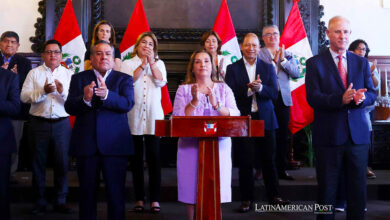The Reasons of the Low Popularity of Pedro Castillo
Practically ten months after taking office as president, the rural professor has been constantly criticized and has failed to consolidate himself in the presidential chair. Why the low popularity of Pedro Castillo?

Photo: Presidency of the Republic of Peru
LatinAmerican Post | Nicolás Donoso Álvarez
Escucha este artículo
Leer en español: Los motivos de la baja popularidad de Pedro Castillo
On July 28 of last year, Pedro Castillo, professor and union leader, was sworn in as president of Peru, after defeating Keiko Fujimori in a controversial, disputed, and close election. It could not be otherwise in a nation that has had six presidents in the last decade, and many of them have been involved in cases of corruption and, therefore, have not even been able to finish their terms in the midst of protests, of a social explosion and endless controversies.
Well, Pedro Castillo appeared as the option of change, wanting to write a new Constitution and replicate the process that is currently being carried out (with more than one controversy) in Chile and sought to transform the State so that it became the charge of sectors that have historically been overshadowed or simply forgotten by the governments of the day. According to the Ipsos pollster, in mid-April, Castillo reached 76% disapproval, the highest since he came to power.
You may also be interested: With Pedro Castillo and Congress of enemies, the crisis in Peru worsens
Far from meeting the high expectations that practically half of the country had for him, Castillo has faltered in the first few months and has been heavily criticized. It should not be forgotten that he was elected as president in a very close election, as mentioned above. In the first round, he led, but only with 18.92% of the votes and with more than 7 million Peruvians who abstained from voting, according to figures provided by the Electoral Office of Electoral Processes (Onpe). Already in the second round, she defeated Keiko Fujimori, but with a "photographic error", since she obtained 50.13% compared to 49.87% for the Popular Front candidate.
Countless Cabinet Changes
One of the main headaches for Castillo has been his cabinet, and since he appointed the first one on July 28, he has already made four changes, and it is not ruled out that he will make another in the coming months. Figures that are really worrying in a country that urgently needs stability and certainty. Perhaps the most notorious error was when he appointed Héctor Valer as prime minister, a congressman whom people associated as an extremist man. The plot was uncovered when different media reported that a judge had imposed precautionary measures on him due to a complaint from his daughter, in which he spoke of attacks on her and his deceased wife.
Valer lasted just three days as prime minister since he had to resign and Castillo once again reformed his cabinet. But this was not the only controversy in which the president was involved, it is enough to remember that in his first cabinet he elected as head of state Guido Belido, a parliamentarian from Peru Libre, an admirer of the Cuban regime and radical reforms, who barely He lasted just over three months in office. His right arm resigned and Castillo explained that this decision was "in favor of governability".
But this is not all and is that these changes seem to turn and collide with each other because Guido Belido's successor was Mirtha Vásquez, who did not reach the age of 4 months when she decided to resign irrevocably due to what she calls a "structural problem of state corruption. And it is already known that the one who replaced her was Héctor Valer, the outcome is already known and currently, the president of the Council of Ministers of Peru is Aníbal Torres.
Presidente @PedroCastilloTe: "La responsabilidad del Gobierno es llegar donde están las necesidades de la población. Desde mi gestión, priorizamos la educación y salud del pueblo peruano como fuente de desarrollo del país". pic.twitter.com/Xlc2Z9NMr4
— Presidencia del Perú ???????? (@presidenciaperu) March 29, 2022
A Free Fall Approval
According to the information provided by Datum, Castillo has the approval of just 12%, while his disapproval already reached 75% at the national level. This rejection in Lima reaches 80% and the age ranges in which it shows a higher level of disapproval are those between 55 and 70 years old, there the figures reach 74%.
These numbers reflect the little governance that the leader has had in all these months, where his constant changes of cabinets, the accusations that led him to a political trial that luckily ended with Congress rejecting his dismissal, and the accusations of corruption that have appeared in recent times have left the rural teacher in a very bad position.
Close to a year in the presidency and with endless controversies and questionable decisions, Pedro Castillo will have to continue sailing in turbulent waters, in a country that requires and demands governance and changes, but which, however, lives in uncertainty and in ungovernability that seems to have no end. Difficult times live in Peru, and that professor and union leader who was sworn in as president will have to rise to the occasion.





